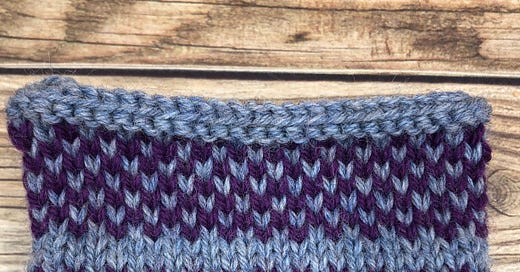Color dominance in stranded knitting
Did you know that when working with stranded knitting, the way you hold the yarns determines which color will "pop" out a bit more. This is known as color dominance.
Basically, the idea is that one color will be slightly above the other on the inside of the fabric and that position determines the dominant color. Here it is in action:
If you look at the purple in the top section of the swatch, it's much more dominant than the purple in the bottom section of the swatch.
I usually work stranded knitting by holding one color in each hand. For the top, purple dominant section, I held the purple in my right hand and the grey in my left hand. For the bottom, grey dominant section, I held the grey in my right hand and the purple in my left hand.
Yarn placement (which strand rides below vs above) as well as tension differences can account for this color dominance. You should make your own swatch(es), holding colors in different ways to see how color dominance works in your own knitting. (For example, according to some resources I checked, based upon which hand I held my yarn in, I should have gotten the opposite result, so my own color dominance may have to do with tension more than yarn placement.)
Then, you can play with this color dominance, making sure that the design that you want to pop out is the one held in the way that will make it dominant. (For this example, I personally like the purple dominant option better here, so would make sure to hold the purple yarn in my right hand.)
If you're wanting to make sure there is no color dominance in your project, you'll need to make sure that you alternate the way the yarn is being held, so that rather than always having one color pass below the other, the strands rotate, spreading out the color dominance. Or, if your tension is what is causing color dominance, you'll need to find a way to knit stranded colorwork with an even tension on each color.
So try things out in swatches and smaller projects to determine your stranded color dominance results, and either use that knowledge as a benefit for a project or work on evening out the colors when that's appropriate for a project.




